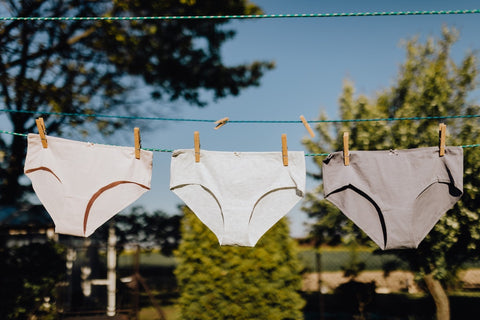(Major note here: lots of these products come with added scents, but your best bet is to stay away from fragrances down there since they can cause itching and irritation.)

What are they? Pads are made from layers of material ranging from cotton to cellulose, often made superabsorbent thanks to the addition of polymers. Most importantly, pads have a sticky material along the bottom, so you can peel off the paper covering and the pad will stick to the underpant below, staying in place. (Big sidenote: a couple of generations ago, the only way to keep a pad in place was to pin it into underpants or to wear a belt with straps attached to the pad - the sticky strip has made pad-wearing far more comfortable!)
Did you know that pads are super customizable? Pantyliners are the thinnest pads and a great option for lighter flows or those days you think you are about to get your period. Overnights the thickest and most absorbent pad option. There are also lots of in-between versions to meet the needs of all levels of flow. Pads also vary by length to provide different amounts of coverage in your underpants. And they come with or without “wings” - extra pieces of material that wrap around the sides of the underwear. Some people love wings because of the extra coverage and protection against leaks, while some hate them because they can stick to your skin if the wings lift off the underpant material. Wings or no wings, pads are one of the most popular period products and a great option!

What are they? Unlike pads that are worn outside of the body (but inside underwear), tampons get inserted into the vagina, where they soak up menstrual blood before it has a chance to drip out. Tampons are made from many of the same materials as pads, woven together into a long, tight cylinder with a string hanging off one end. Most tampons come inside an applicator made from plastic or cardboard - the applicator helps guide the tampon in, but it’s not at all necessary and there are tampon brands that don’t even offer the applicator in the first place. After the tampon is inserted and the applicator is removed, the string hangs out of the vagina just enough - about an inch or two. When it’s time to take out the tampon, locate the string, pull, and out it comes.
Because they go inside the body, tampons are a great option for activities like swimming and dancing - pads are often too bulky for gym or dance and they’re not waterproof.
Tampons cannot be left inside the body for extended periods of time - any foreign object in the body poses a risk for infection, and tampons in particular can trigger something called toxic shock syndrome. That’s why you will read over and over again that tampons should be removed after 4 - 8 hours of use. A helpful reminder to take it out comes on heavy bleeding days, when after a few hours the tampon won’t be able to absorb more blood and it will probably leak anyhow.

What are they? Menstrual cups are inserted into the vagina just like tampons, but they aren’t designed to absorb blood - instead, they are cups made of silicone or latex that actually catch the menstrual blood instead of soaking it up.
A few menstrual cup pros: they can be left in longer than tampons, up to 12 hours; they’re reusable, making them environmentally friendly period products; and, similar to tampons, menstrual cups can also be worn for activities like swimming. However, a big con for many girls is getting comfortable with taking out the cup and washing it, since this can be a little messy.

What is it? Period underwear is the newest addition to the menstrual product array, and it’s amazing! Period underwear uses hyper-absorbent materials in the crotch of the underpant to catch blood. Wearing them is like having a permanent, invisible pad tucked inside a pair of comfy underwear.
One great feature of period underwear is that it has very little bulk, but this means that on heavy flow days, period underwear alone may not do the trick. Still, these can be great to wear in addition to a tampon to protect against leaks on heavy flow days. Like menstrual cups, period underwear needs to be changed and washed regularly. Once girls get over that, they often say how grateful they are to have a product which ends any chance that they will face that dreaded situation of not knowing her period has arrived while someone walking behind her does...
No matter what period products you decide to use, these are all great options, so choose the product that works best for you! There’s no right or wrong option, and you aren’t limited to just one type of product! Sometimes, it takes trying a few options to find feels most comfortable, and that’s perfectly normal.





Leave a comment
All comments are moderated before being published.
This site is protected by hCaptcha and the hCaptcha Privacy Policy and Terms of Service apply.